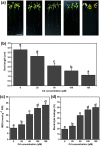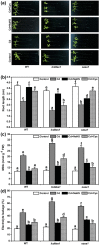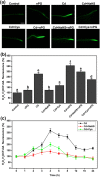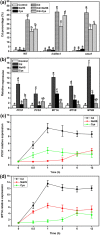Hydrogen sulfide - cysteine cycle system enhances cadmium tolerance through alleviating cadmium-induced oxidative stress and ion toxicity in Arabidopsis roots
- PMID: 28004782
- PMCID: PMC5177925
- DOI: 10.1038/srep39702
Hydrogen sulfide - cysteine cycle system enhances cadmium tolerance through alleviating cadmium-induced oxidative stress and ion toxicity in Arabidopsis roots
Abstract
Cadmium (Cd2+) is a common toxic heavy metal ion. We investigated the roles of hydrogen sulfide (H2S) and cysteine (Cys) in plant responses to Cd2+ stress. The expression of H2S synthetic genes LCD and DES1 were induced by Cd2+ within 3 h, and endogenous H2S was then rapidly released. H2S promoted the expression of Cys synthesis-related genes SAT1 and OASA1, which led to endogenous Cys accumulation. The H2S and Cys cycle system was stimulated by Cd2+ stress, and it maintained high levels in plant cells. H2S inhibited the ROS burst by inducing alternative respiration capacity (AP) and antioxidase activity. H2S weakened Cd2+ toxicity by inducing the metallothionein (MTs) genes expression. Cys promoted GSH accumulation and inhibited the ROS burst, and GSH induced the expression of phytochelatin (PCs) genes, counteracting Cd2+ toxicity. In summary, the H2S and Cys cycle system played a key role in plant responses to Cd2+ stress. The Cd2+ tolerance was weakened when the cycle system was blocked in lcddes1-1 and oasa1 mutants. This paper is the first to describe the role of the H2S and Cys cycle system in Cd2+ stress and to explore the relevant and specificity mechanisms of H2S and Cys in mediating Cd2+ stress.
Figures









Similar articles
-
An emphasis of hydrogen sulfide-cysteine cycle on enhancing the tolerance to chromium stress in Arabidopsis.Environ Pollut. 2016 Jun;213:870-877. doi: 10.1016/j.envpol.2016.03.035. Epub 2016 Mar 31. Environ Pollut. 2016. PMID: 27038574
-
WRKY13 Enhances Cadmium Tolerance by Promoting D-CYSTEINE DESULFHYDRASE and Hydrogen Sulfide Production.Plant Physiol. 2020 May;183(1):345-357. doi: 10.1104/pp.19.01504. Epub 2020 Mar 16. Plant Physiol. 2020. PMID: 32179630 Free PMC article.
-
Eugenol Confers Cadmium Tolerance via Intensifying Endogenous Hydrogen Sulfide Signaling in Brassica rapa.J Agric Food Chem. 2018 Sep 26;66(38):9914-9922. doi: 10.1021/acs.jafc.8b03098. Epub 2018 Sep 14. J Agric Food Chem. 2018. PMID: 30188702
-
[Mechanisms of heavy metal cadmium tolerance in plants].Zhi Wu Sheng Li Yu Fen Zi Sheng Wu Xue Xue Bao. 2006 Feb;32(1):1-8. Zhi Wu Sheng Li Yu Fen Zi Sheng Wu Xue Xue Bao. 2006. PMID: 16477124 Review. Chinese.
-
The central role of hydrogen sulfide in plant responses to toxic metal stress.Ecotoxicol Environ Saf. 2018 Aug 15;157:403-408. doi: 10.1016/j.ecoenv.2018.03.060. Ecotoxicol Environ Saf. 2018. PMID: 29653374 Review.
Cited by
-
Role of methylglyoxal and glyoxalase in the regulation of plant response to heavy metal stress.Plant Cell Rep. 2024 Mar 19;43(4):103. doi: 10.1007/s00299-024-03186-y. Plant Cell Rep. 2024. PMID: 38502356 Review.
-
Decoding Heavy Metal Stress Signalling in Plants: Towards Improved Food Security and Safety.Plants (Basel). 2020 Dec 16;9(12):1781. doi: 10.3390/plants9121781. Plants (Basel). 2020. PMID: 33339160 Free PMC article. Review.
-
Alternative Pathway Is Involved in Hydrogen Peroxide-Enhanced Cadmium Tolerance in Hulless Barley Roots.Plants (Basel). 2021 Oct 28;10(11):2329. doi: 10.3390/plants10112329. Plants (Basel). 2021. PMID: 34834692 Free PMC article.
-
Differential Regulation of Genes Involved in Root Morphogenesis and Cell Wall Modification is Associated with Salinity Tolerance in Chickpea.Sci Rep. 2018 Mar 19;8(1):4855. doi: 10.1038/s41598-018-23116-9. Sci Rep. 2018. PMID: 29555923 Free PMC article.
-
Crosstalk between Melatonin and Reactive Oxygen Species in Plant Abiotic Stress Responses: An Update.Int J Mol Sci. 2022 May 18;23(10):5666. doi: 10.3390/ijms23105666. Int J Mol Sci. 2022. PMID: 35628474 Free PMC article. Review.
References
-
- Bolan N. S. et al.. Chapter Four—Cadmium Contamination and Its Risk Management in Rice. Ecosystems Adv. Agron. 119, 183–273 (2013).
-
- Sun H. et al.. Association of cadmium in urine and blood with age in a general population with low environmental exposure. Chemosphere. 156, 392–397 (2016). - PubMed
-
- Kan Q. et al.. Nitrate reductase-mediated NO production enhances Cd accumulation in Panax notoginseng roots by affecting root cell wall properties. J. Plant Physiol. 193, 64–70 (2016). - PubMed
-
- Sandalio L. M., Dalurzo H. C., Gómez M., Romero-Puertas M. C. & del Río L. A. Cadmium-induced changes in the growth and oxidative metabolism of pea plants. J. Exp. Bot. 52, 2115–2126 (2001). - PubMed
-
- Ortega-Villasante C., Rellán-Álvarez R., Del Campo F. F., Carpena-Ruiz R. O. & Hernández L. E. Cellular damage induced by cadmium and mercury in Medicago sativa. J. Exp. Bot. 56, 2239–2251 (2005). - PubMed
Publication types
MeSH terms
Substances
LinkOut - more resources
Full Text Sources
Other Literature Sources
Research Materials

